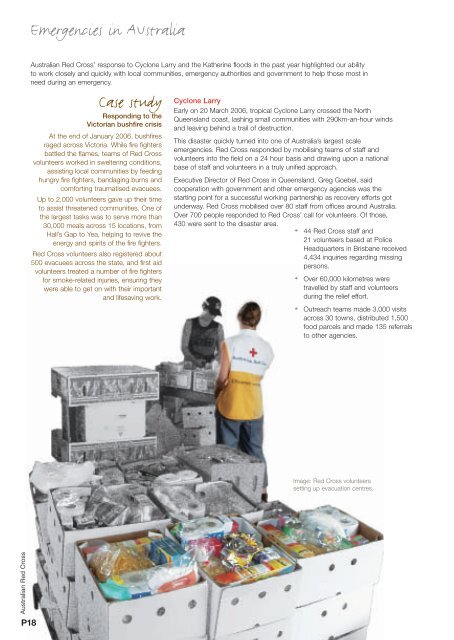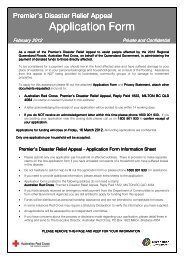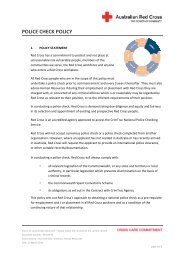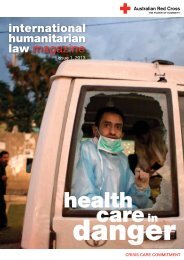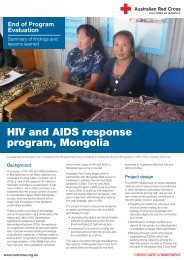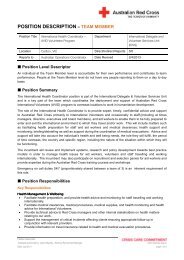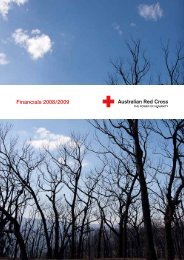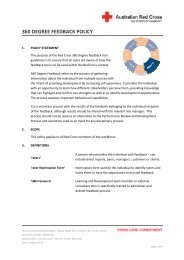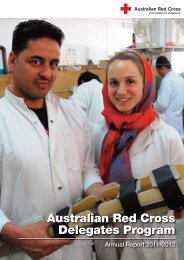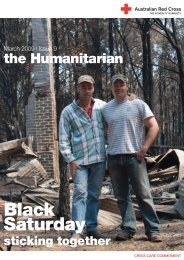Annual report - Australian Red Cross
Annual report - Australian Red Cross
Annual report - Australian Red Cross
You also want an ePaper? Increase the reach of your titles
YUMPU automatically turns print PDFs into web optimized ePapers that Google loves.
Emergencies in AUstralia<br />
<strong>Australian</strong> <strong>Red</strong> <strong>Cross</strong>’ response to Cyclone Larry and the Katherine floods in the past year highlighted our ability<br />
to work closely and quickly with local communities, emergency authorities and government to help those most in<br />
need during an emergency.<br />
Case study<br />
Responding to the<br />
Victorian bushfire crisis<br />
At the end of January 2006, bushfires<br />
raged across Victoria. While fire fighters<br />
battled the flames, teams of <strong>Red</strong> <strong>Cross</strong><br />
volunteers worked in sweltering conditions,<br />
assisting local communities by feeding<br />
hungry fire fighters, bandaging burns and<br />
comforting traumatised evacuees.<br />
Up to 2,000 volunteers gave up their time<br />
to assist threatened communities. One of<br />
the largest tasks was to serve more than<br />
30,000 meals across 15 locations, from<br />
Hall’s Gap to Yea, helping to revive the<br />
energy and spirits of the fire fighters.<br />
<strong>Red</strong> <strong>Cross</strong> volunteers also registered about<br />
500 evacuees across the state, and first aid<br />
volunteers treated a number of fire fighters<br />
for smoke-related injuries, ensuring they<br />
were able to get on with their important<br />
and lifesaving work.<br />
Cyclone Larry<br />
Early on 20 March 2006, tropical Cyclone Larry crossed the North<br />
Queensland coast, lashing small communities with 290km-an-hour winds<br />
and leaving behind a trail of destruction.<br />
This disaster quickly turned into one of Australia’s largest scale<br />
emergencies. <strong>Red</strong> <strong>Cross</strong> responded by mobilising teams of staff and<br />
volunteers into the field on a 24 hour basis and drawing upon a national<br />
base of staff and volunteers in a truly unified approach.<br />
Executive Director of <strong>Red</strong> <strong>Cross</strong> in Queensland, Greg Goebel, said<br />
cooperation with government and other emergency agencies was the<br />
starting point for a successful working partnership as recovery efforts got<br />
underway. <strong>Red</strong> <strong>Cross</strong> mobilised over 80 staff from offices around Australia.<br />
Over 700 people responded to <strong>Red</strong> <strong>Cross</strong>’ call for volunteers. Of those,<br />
430 were sent to the disaster area.<br />
44 <strong>Red</strong> <strong>Cross</strong> staff and<br />
21 volunteers based at Police<br />
Headquarters in Brisbane received<br />
4,434 inquiries regarding missing<br />
persons.<br />
Over 60,000 kilometres were<br />
travelled by staff and volunteers<br />
during the relief effort.<br />
Outreach teams made 3,000 visits<br />
across 30 towns, distributed 1,500<br />
food parcels and made 135 referrals<br />
to other agencies.<br />
Image: <strong>Red</strong> <strong>Cross</strong> volunteers<br />
setting up evacuation centres.<br />
<strong>Australian</strong> <strong>Red</strong> <strong>Cross</strong><br />
P18


